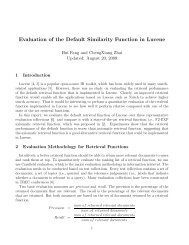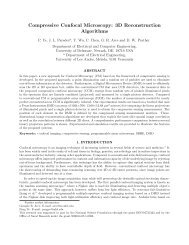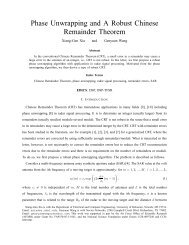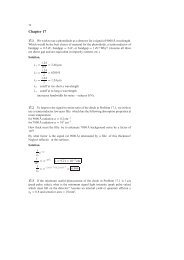Intel IXA SDK ACE Programming Framework - Department of ...
Intel IXA SDK ACE Programming Framework - Department of ...
Intel IXA SDK ACE Programming Framework - Department of ...
You also want an ePaper? Increase the reach of your titles
YUMPU automatically turns print PDFs into web optimized ePapers that Google loves.
In This Guide<br />
l<br />
l<br />
l<br />
l<br />
l<br />
l<br />
l<br />
l<br />
l<br />
l<br />
l<br />
l<br />
Chapter 2, “Elements <strong>of</strong> an Application,” which introduces the <strong>IXA</strong> system s<strong>of</strong>tware,<br />
the C structures that support the <strong>ACE</strong> model, the error handling system,<br />
and the application building process<br />
Chapter 3, “Compiling and Testing Applications,” which explains the compilation<br />
model for an application containing <strong>ACE</strong>s<br />
Chapter 4, “Configuring and Starting <strong>IXA</strong> Systems,” which explains how to<br />
configure the ports and start the <strong>ACE</strong>s for an <strong>IXA</strong> system<br />
Chapter 5, “Controlling Packet Flow,” which introduces targets as destinations<br />
for packets and explains how packets flow into and out <strong>of</strong> an IXP1200 and <strong>ACE</strong>s<br />
within an application<br />
Chapter 6, “Writing Micro<strong>ACE</strong>s,” which explains the architecture <strong>of</strong> micro<strong>ACE</strong>s<br />
and describes how to write them<br />
Chapter 7, “Interface <strong>ACE</strong>s,” which introduces the system-defined micro<strong>ACE</strong>s<br />
that receive and transmit packets on network interface ports<br />
Chapter 8, “Stack and Library <strong>ACE</strong>s,” which introduces the system-defined<br />
micro<strong>ACE</strong> that represents the Linux TCP/IP stack and library <strong>ACE</strong>s that perform<br />
common networking tasks<br />
Chapter 9, “Classifying Packets Using NCL,” which introduces the Network<br />
Classification Language and explains how to use it to evaluate packets and write<br />
classification rules<br />
Chapter 10, “Initializing and Acting on Packets in an <strong>ACE</strong>,” which describes<br />
some <strong>of</strong> the actions that you can take on packets and explains how to implement<br />
action functions<br />
Chapter 11, “Communication Within an Application,” which shows how to use<br />
the crosscall mechanism for remote function calls between <strong>ACE</strong>s and other<br />
programs<br />
Chapter 12, “Crosscall Example,” which demonstrates the use <strong>of</strong> crosscalls<br />
Chapter 13, “Using Sets <strong>of</strong> Data to Classify Packets,” which describes how to<br />
create sets to associate application data with packets, and how to perform and act<br />
on the results <strong>of</strong> searches in the sets<br />
x<br />
About This Guide<br />
Revision 3.3, August 2001











